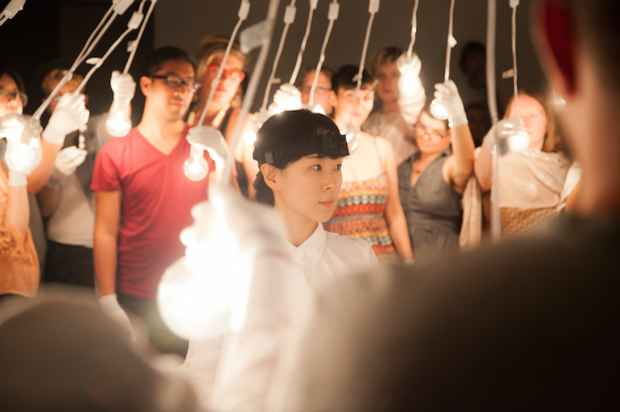“Remains” Exhibition
Fergus McCaffrey (514 W 26th St.)

[Image: Hee Ran Lee "50 Bulbs" Rapid Pulse International Performance Art Festival, Defibrillator Gallery, Chicago, performance still, 2016 © The Artist}
This event has ended.
Fergus McCaffrey is known for its scholarship of, and advocacy for, artists from the Gutai Art Association (1954–72). The Gutai movement, composed of a group of postwar Japanese artists, reconceived the artist’s relationship between body and matter, creating radically performative work. Rejecting the idea that the artist’s body is absent from a work of art is evident in the meaning of the name Gutai, which translates as “embodiment.” From Kazuo Shiraga’s 1955 Challenging Mud, in which he wrestled in two tons of mud and unset concrete, to Atsuko Tanaka’s 1956 Electric Dress, where she donned a “dress” of hand-painted incandescent bulbs, the emphasis on the artist’s body as a tool in creating a work is vital and evident. The embodied practice of Gutai artists influenced generations of Western performance artists, and the spirit of Gutai still resonates today in contemporary performance art practice.
REMAINS brings together a diverse group of performance- based artists who, like the artists of the Gutai movement, use their bodies as a tool and a way of effecting change both materially and conceptually. Throughout the course of the show, the gallery will become an evolving site of experimentation by the artists, a laboratory of exploration through embodied actions. The performance artists in REMAINS will transform the Fergus McCaffrey space by working site-specifically to evolve, shift, and change both materials and the environment.
Nigel Rolfe uses finely ground natural minerals to create gestured marks on himself, nearby materials, and the space around him. After the performance, the powder remains, a suggestion of the symbolic dust we all emerge from and to which we all return. The often brightly colored pigments in Rolfe’s work contrast with the rich, dark coffee grounds of Clifford Owens’s scatological marks on paper, referencing the profanity of the body. The motions of his actions can be seen on the surface of the paper and reimagined long after the performance is past. Unlike Owens’s use of paper as a surface on which to make an embodied mark, Liping Ting’s Paper Timing / Stone Timing is marked by the slow action of crawling through a mountain of crumpled paper, with contact microphones amplifying her voice and the sound of her movement. Ting’s ongoing investigation into the interplay between her body and language will layer over time as she marks the windows with texts and symbols during a series of durational performances. Máiréad Delaney’s physically strenuous performances put her in a precarious position; she uses her body as a tool in a form of protest, referencing the body through logs cut with bone saws, the cracked pelvis of a heifer, and long branches of wild thorns. In Hee Ran Lee’s work, 50 Bulbs, the audience members become collaborators in the performance, and they each hold the safety of the artist in their hands when she requests that they swing lightbulbs at her head. The resulting effects—the extinguishing of light, breaking of glass, and puffs of smoke surrounding the artist—make the audience active participants, not passive spectators. Also uniquely engaging the audience, Daniel Neumann’s sound installation, Phase Field, invites the viewer toward the site-specific modified speaker-objects, with the sound growing louder and softer in relation to each person’s physical relationship to the work.
Media
Schedule
from July 06, 2017 to August 11, 2017
Opening Reception on 2017-07-06 from 18:00 to 20:30